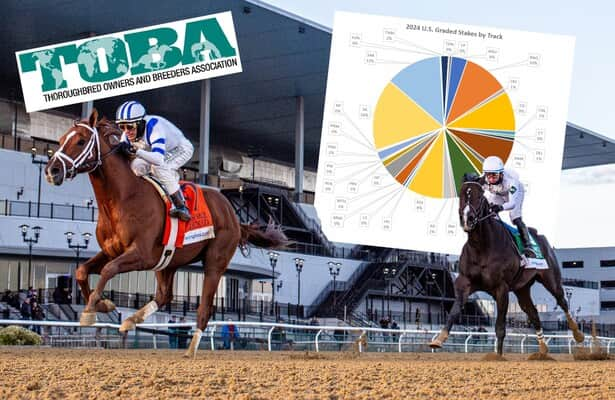Will Cigar Mile become a Grade 1? Committee decides this week

Photo:
Jason Moran / Eclipse Sportswire – edited
The $500,000 Cigar Mile this month was a touchstone for defining a
Grade 1 race. Conventional wisdom said it had the rich history, decorated
alumni and most noticeably a big field with five millionaires, four top-level
winners and three graduates of Breeders’ Cup 2024.
So it walked like a duck and talked like a duck. Whether the best race of the Aqueduct autumn will remain a Grade 2 for the third year going will be decided Monday and Tuesday, when the Thoroughbred Owners and Breeders
Association gathers its 11-member American Graded Stakes Committee in
Lexington, Ky.
Flashback: How the committee graded stakes a year ago.
If recent history means anything, there will be fewer Grade
1 races in 2025. That has been the ongoing trend since 2009, when there were
115 top-level stakes out of a record 489 graded races. Those numbers shrunk
gradually to 93 out of 429. The 1s made up 22% of the graded stakes this year.
In 2009 it was 24%.

It is meant to be that way. According to the TOBA website, “Total
number of graded races and the distribution of particular grades among the
races are monitored by the committee to retain the approximate shape of a
pyramid (with) Grade 1 races being the least numerous, Grade 2 races next and
Grade 3 races the most numerous.”
If the Cigar Mile were to be restored to its old perch, it
would reverse a trend. It was one of the six New York Racing Association races that were dropped
from Grade 1 to Grade 2 in the past five years. So were the Vosburgh, Flower
Bowl, Woodward, Carter Handicap and Man o’ War. Only the Saratoga Derby
Invitational and New York Stakes were boosted in that time to the top category on
the NYRA calendar.
With its eroding purses and ever skimpier fields in key races, Southern
California would seem to be the most vulnerable to demotions. Recent history
has reflected all that. Santa Anita and Los Alamitos had a combined six Grade
1s cut to Grade 2s since 2020, including the Chandelier, Santa Anita Oaks, Santa
Anita Sprint Championship, Starlet, Rodeo Drive and Hollywood Gold Cup. It has
gained none.
High-profile races like the Santa Anita Handicap, the Santa
Anita Derby and Malibu have not had full fields in years. All three have
absorbed purse cuts recently with the Big ’Cap and Malibu down to the Grade 1
minimum $300,000 each. They averaged no more than 7.6 starters per year since
2020.
The five-year period is important. As the TOBA website put
it, “Information supplied to the members of the (committee) includes
statistical data for the last five years for all eligible races indicating
quality of the field.” That quality is based on career performances, graded
wins and even Thoro-Graph ratings.
Promoting a race is tougher than demoting one. It takes eight of
11 votes to move a race up but only a simple majority to drop it.
Since they are human beings who will be focused for two long
days on the makeup and results of nearly 1,000 races, arm-twisting also will be
a factor as it has been since TOBA launched the evaluation process in 1973.
“Judgment and flexibility,” the TOBA website says, “thus
must always be a part of the system.”
Horse Racing Nation readers and social-media
followers weighed in via recent comments and social-media posts.




About the Cigar Mile being a Grade 2 race:

As the committee prepares to hunker down for its annual
assignment, here are some facts that may or may not be worth considering. For instance, there is the number of Grade 1s in each state this year.
| Grade 1s by state | 2024 | 2024 | ||
|---|---|---|---|---|
| New York | 31 | Arkansas | 2 | |
| California | 19 | Pennsylvania | 2 | |
| Kentucky | 19 | Maryland | 1 | |
| Breeders’ Cup | 14 | New Jersey | 1 | |
| Florida | 3 | Virginia | 1 |
These are the 11 committee members who are charged with deciding the classifications from black type and listed all the way to Grade 1:
| Amer. Gr. Stakes Cmte. | Affiliation |
|---|---|
| Brant Laue* | owner, Laue Ranch Racing Stable |
| Barbara Banke | owner, Stonestreet Stables |
| Walker Hancock | outgoing president, Claiborne Farm |
| Billy Koch | managing partner, Little Red Feather Racing |
| David O’Farrell | general manager, Ocala Stud |
| Racing officials | |
| Alex Solis II | bloodstock agent & partner, Solis-Litt Bloodstock |
| Gatewood Bell | vice president of racing, Keeneland |
| Dan Bork | stakes coordinator, Churchill Downs & Ellis Park |
| Martin Panza | racing operations co-director, Kentucky Downs |
| Rick Hammerle | consultant, 1/ST Racing |
| Tora Yamaguchi | racing coordinator, Del Mar |
| *TOBA chairperson |
If last year provided any precedent, the committee met early in the week and revealed its list of 2024 grades that Saturday. That means the best advice is to hurry up and wait.
Related
Leading Parx jockey Sanchez will serve 7-day suspension
Photo: Jason Moran / Eclipse Sportswire Jockey Mychel Sanchez will serve a seven-day suspension and pay an additional $1,750 in fines
Bill Mott talks about plans for Sovereignty, Just F Y…
Photo: Gulfstream Park / Lauren King Sovereignty, dramatic late-running winner of the Fountain of Youth (G2) March 1, is being pointed
Up-and-coming Cavalieri chases Grade 1 glory in Beholder Mile
Photo: Santa Anita / Benoit Photo Cavalieri and Alpha Bella, who finished one-two in the Grade 3 La Cañada in January at Santa Anita,
4 stakes showcase shipping stars on Tampa Bay undercard
Photo: Gonzalo Anteliz Jr. / Eclipse Sportswire The stars will shine Saturday at Tampa Bay Downs, and not just in the Grade 3 Tampa Ba











